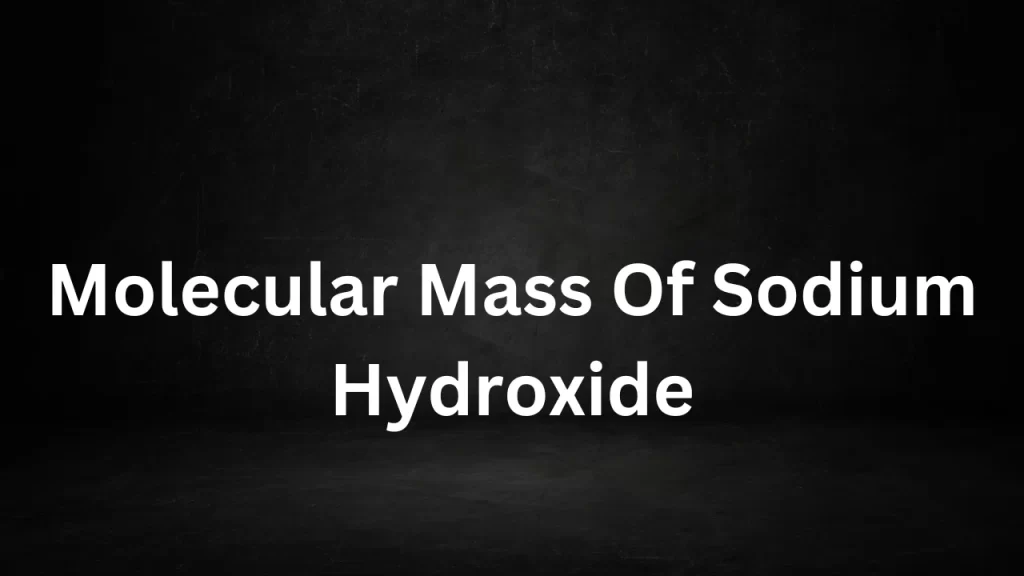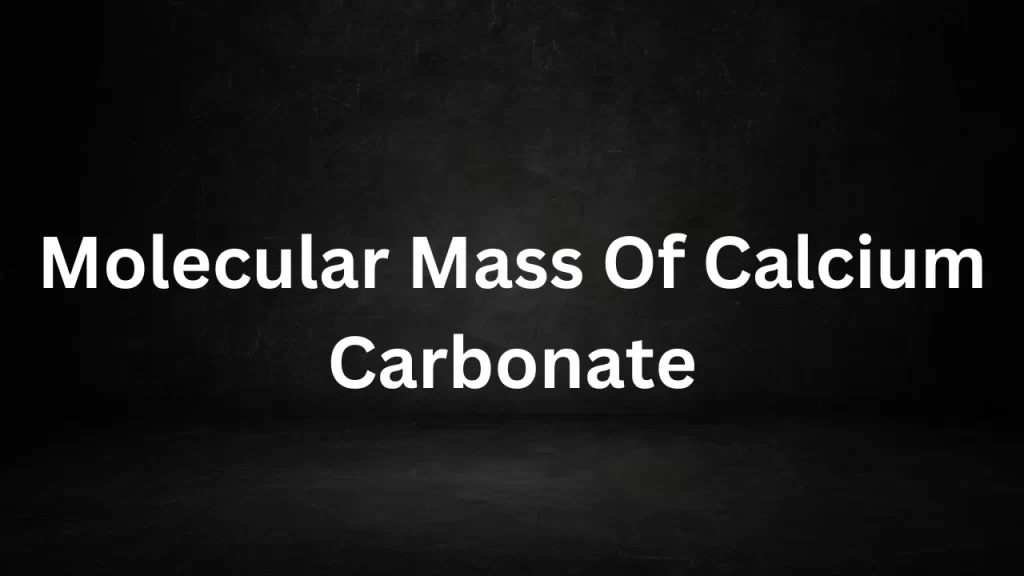Category: Class 9
Molecular Weight Of Silver
Molecular Weight Of Silver: Silver is a fascinating element that has captured human interest for thousands of years due to its lustrous appearance and valuable properties. Whether it’s used for making jewelry, coins, or in various industrial applications, silver’s molecular weight plays a crucial role in understanding its behavior and applications.
In this article, we will delve into the concept of molecular weight, explore how it is calculated for silver, and discuss its significance in different contexts.

Molecular Weight Of Silver
What is Molecular Weight?
Molecular weight, also known as mole mass or molar mass, is a fundamental concept in chemistry. It represents the mass of a molecule, compound, or element in atomic mass units (amu). Molecular weight is the sum of the atomic weights of all the atoms in a molecule. It is a crucial parameter in various chemical calculations, including stoichiometry, molarity, and the determination of reaction yields.
The Atomic Structure of Silver
To understand the mole weight of silver, we must first examine its atomic structure. Silver has an atomic number of 47, meaning it has 47 electrons and 47 protons in its nucleus. The most common isotope of silver is Ag-107, which has 60 neutrons. Silver also has another stable isotope, Ag-109, which has 62 neutrons.
Calculating the Molecular Weight of Silver
To calculate the mole weight of silver, we consider its most abundant isotope, Ag-107. The mole weight of silver is calculated by summing the atomic weights of all its constituent atoms. Here’s the breakdown:
Atomic weight of silver (Ag): Approximately 107.8682 amu
Since a silver atom is monatomic, its mole weight is the same as its atomic weight, which is approximately 107.8682 amu.
Significance of Molecular Weight in Silver
- Chemical Reactions: Molecular weight is crucial in stoichiometry, the study of reactants and products in chemical reactions. It helps determine the ratio in which substances react, which is essential for predicting the outcome of chemical reactions involving silver.
- Molarity Calculations: Molecular weight is used to calculate the molarity of a silver-containing solution. Molarity is a measure of the concentration of a solute in a solution, and knowing the mole weight is vital for these calculations.
- Industrial Applications: In various industrial applications, such as electronics and photography, the precise mole weight of silver is essential to ensure the quality and consistency of products.
- Precious Metal Valuation: Molecular weight plays a role in determining the value of silver, especially in the context of precious metal trading. The price of silver is often quoted per troy ounce, and its mole weight is used to convert between weight and monetary value.
Conclusion
Understanding the mole weight of silver is fundamental to both the field of chemistry and its various applications. It provides essential information for chemical calculations, molarity determinations, and plays a significant role in the valuation of this precious metal. As we continue to explore the properties and applications of silver, the mole weight remains a critical parameter that aids our understanding of its behavior and utility in various industries.
Read More
- Molecular Mass Of KCl
- Molecular Mass Of Fe
- Molecular Weight Of H2
- Molar Mass Of Methane
- Molecular Mass Of Sodium Hydroxide
Frequently Askked Questions (FAQs) On Molecular Weight Of Silver
1. What is the molecular weight of silver?
The mole weight of silver is approximately 107.8682 atomic mass units (amu). This value is calculated based on the atomic weight of the most abundant stable isotope of silver, Ag-107.
2. Why is the molecular weight of silver important?
The mole weight of silver is important in various chemical calculations, including stoichiometry, molarity calculations, and determining the value of silver in industrial and precious metal contexts. It helps scientists and chemists understand how silver atoms combine and react in chemical processes.
3. How is the molecular weight of silver calculated?
The mole weight of silver is calculated by summing the atomic weights of all the atoms in a silver molecule. Since silver is a monatomic element, its mole weight is the same as its atomic weight, which is approximately 107.8682 amu.
4. Are there different isotopes of silver, and do they affect its molecular weight?
Yes, silver has two stable isotopes: Ag-107 and Ag-109. Ag-107 is the most abundant isotope, while Ag-109 is less common. However, the mole weight is primarily based on the most abundant isotope, Ag-107, which has 60 neutrons. Ag-109, with 62 neutrons, is less abundant and does not significantly affect the molecular weight of silver.
5. What is the significance of knowing the molecular weight of silver in industrial applications?
In industrial applications, such as electronics, photography, and metallurgy, knowing the mole weight of silver is crucial for ensuring product quality and consistency. It helps manufacturers accurately measure and mix silver-based materials, which is essential for achieving desired properties and performance.
Molecular Mass Of KCl
Molecular Mass Of KCl:Potassium chloride, denoted by its chemical formula KCl, stands as a widely acknowledged compound celebrated for its versatile utility across various domains, including medicine, agriculture, and food processing. In this article, we shall explore the molecular mass of potassium chloride, its importance, and its multifaceted applications in distinct fields.

Molecular Mass Of KCl
Understanding Potassium Chloride (KCl)
Potassium chloride, commonly denoted as KCl, constitutes a chemical compound containing two fundamental elements: potassium (K) and chlorine (Cl). Typically, it exists in the form of a white crystalline powder or granules. Potassium chloride finds extensive applications as a potassium source in fertilizers to promote plant growth, in culinary endeavors, and within the medical sphere, serving as an electrolyte replenishment solution.
Molecular Mass of Potassium Chloride
The molecular mass of potassium chloride is determined by adding together the atomic masses of its constituent elements:
- Atomic mass of potassium (K) ≈ 39.10 amu (atomic mass units)
- Atomic mass of chlorine (Cl) ≈ 35.45 amu
Now, let’s calculate the molecular mass of potassium chloride (KCl):
Molecular Mass of KCl = (1 × Atomic mass of K) + (1 × Atomic mass of Cl)
The Molecular Mass of KCl = (1 × 39.10 amu) + (1 × 35.45 amu)
Molecular Mass of KCl ≈ 74.55 amu
Therefore, the mole mass of potassium chloride is approximately 74.55 atomic mass units (amu).
Significance of Molecular Mass
The mole mass of potassium chloride is significant in several ways:
- Chemical Formulas: Molecular mass aids in determining the molecular weight of a compound, which is essential for understanding chemical reactions and stoichiometry.
- Medicine: In the medical domain, a comprehensive understanding of the molecular mass of potassium chloride is essential for precise patient dosing, particularly when it serves as an electrolyte replacement in intravenous fluids.
- Agriculture: In agriculture, the molecular mass plays a role in the formulation of fertilizers, ensuring the correct ratio of potassium for plant growth.
- Food Industry: The molecular mass plays a pivotal role in the sphere of food processing, especially when potassium chloride is utilized as a salt substitute or a flavor enhancer in low-sodium food items.
- Chemical Industry: Knowledge of the molecular mass is vital for manufacturers in the chemical industry to produce potassium chloride-based products accurately.
Conclusion
The mole mass of potassium chloride (KCl) is approximately 74.55 atomic mass units (amu). Understanding this value is crucial in various applications, including medicine, agriculture, and the food industry. Whether it’s promoting plant growth, replenishing electrolytes in medical settings, or enhancing the flavor of low-sodium foods, the molecular mass of potassium chloride plays a fundamental role in its diverse array of applications in our daily lives.
Read More
- Molecular Mass Of Fe
- Molecular Weight Of H2
- Molar Mass Of Methane
- Molecular Mass Of Sodium Hydroxide
- Molar Mass Of Ethyl Alcohol
Frequently Asked Questions (FAQs) On Molecular Mass Of KCl
1. What is KCl, and what does it stand for?
KCl is the chemical formula for potassium chloride. It is a chemical compound composed of potassium (K) and chlorine (Cl) atoms.
2. Can the molecular mass of KCl vary in different forms or compositions?
The molecular mass of KCl remains consistent, as it is a fundamental property of the compound. However, impurities or additives in commercial products may result in slight variations.
3. Why is the molecular mass of KCl significant in chemistry?
The mole mass of KCl is essential in chemistry as it helps determine the mole weight of the compound. This information is crucial for stoichiometry, chemical reactions, and the formulation of various products.
4. Is KCl commonly found in nature?
Indeed, potassium chloride is naturally present in certain mineral deposits, frequently in conjunction with salt deposits, predominantly sodium chloride. Moreover, trace amounts of potassium chloride can be detected in various food items.
5. What are some other applications of KCl beyond those mentioned?
Potassium chloride finds utility within the chemical industry, where it contributes to the manufacturing of a diverse range of chemical compounds and products. Additionally, it serves a purpose in processes related to water treatment and metallurgy.
Molecular Mass Of Fe
Molecular Mass Of Fe: Molecular mass, also known as molar mass, is a fundamental concept in chemistry that helps us understand the properties and behavior of substances at the molecular level.
In this article, we delve into the molecular mass of Fe, which represents iron, one of the most abundant and essential elements on Earth. Understanding the molecular mass of iron is crucial in various scientific and industrial applications.

Molecular Mass Of Fe
Understanding Molecular Mass
Before we explore the molecular mass of Fe, it’s essential to grasp the concept itself. Molecular mass refers to the mass of a molecule, expressed in atomic mass units (amu) or unified atomic mass units (u). This quantity is ascertained by summing the atomic masses of all the atoms contained within a molecule. For iron (Fe), this calculation involves considering the atomic mass of a single iron atom.
The Composition of Iron (Fe)
Iron (Fe) is an element, and its mole mass refers to the atomic mass of a single iron atom. The atomic mass of iron is approximately 55.85 amu or 55.85 u.
Calculation of Molecular Mass of Fe
The mole mass of Fe is equal to the atomic mass of a single iron atom:
Molecular Mass of Fe = Atomic Mass of Fe Molecular Mass of Fe = 55.85 amu (or u)
Therefore, the molecular mass of Fe is approximately 55.85 atomic mass units (amu) or unified atomic mass units (u).
Significance of Iron (Fe)
Iron is a vital element with significant importance in various fields:
- Abundance: Iron is one of the most abundant elements on Earth and is found in various forms, including ores, minerals, and in the Earth’s core. It is a crucial component of our planet’s geology.
- Industrial Applications: Iron and its alloys, including steel, have extensive applications in the construction, manufacturing, and transportation sectors. Steel, renowned for its robustness and longevity, is especially recognized.
- Biological Role: Iron is essential for living organisms, playing a crucial role in hemoglobin, a protein that transports oxygen in our blood. It also participates in enzymatic reactions and various metabolic processes.
- Technological Advancements: Iron is a key element in the production of magnets, electric motors, and various electronic devices.
Applications of Molecular Mass
Understanding the mole mass of elements like iron (Fe) has several applications in chemistry and related fields:
- Stoichiometry: Molecular mass is crucial in stoichiometry, helping determine the quantities of reactants and products in chemical reactions.
- Analytical Chemistry: Molecular mass is applied in mass spectrometry, a technique used for the identification and quantification of compounds.
- Materials Science: In materials science, the molecular mass of elements and compounds influences the properties of materials, including their strength, conductivity, and reactivity.
Conclusion
The mole mass of Fe, approximately 55.85 atomic mass units (amu) or unified atomic mass units (u), reflects the atomic mass of a single iron atom. Iron is a ubiquitous and essential element with diverse applications, ranging from construction to biology and technology. Understanding the molecular mass of elements like iron is fundamental in chemistry and contributes to advancements in science, industry, and our daily lives.
Read More
- Molecular Weight Of H2
- Molar Mass Of Methane
- Molecular Mass Of Sodium Hydroxide
- Molar Mass Of Ethyl Alcohol
- Molecular Mass Of Calcium Carbonate
Frequently Asked Questions (FAQs) On Molecular Mass Of Fe
1. What is the molecular mass of Fe (iron)?
The mole mass of Fe (iron) is approximately 55.85 atomic mass units (amu) or unified atomic mass units (u). This value represents the atomic mass of a single iron atom.
2. Why is the molecular mass of iron important?
The mole mass of iron is important because it provides information about the atomic mass of a single iron atom. It constitutes a fundamental principle in the realm of chemistry and finds application in stoichiometry, analytical chemistry, and materials science.
3. How do you calculate the molecular mass of Fe?
The molecular mass of Fe is determined by taking into account the atomic mass of an individual iron atom, which is approximately 55.85 amu (or u).
4. What is the significance of iron (Fe) in various fields?
Iron is a vital element with significance in geology, industry, biology, and technology. It is abundant in the Earth’s crust, widely used in construction and manufacturing, essential for living organisms (especially in hemoglobin), and plays a role in technological advancements.
5. What are the applications of the molecular mass of Fe (iron) in the field of chemistry?
The mole mass of Fe is utilized in stoichiometry to ascertain the quantities of reactants and products in chemical reactions. Furthermore, it finds application in analytical chemistry, notably in mass spectrometry.
Molecular Weight Of H2
Molecular Weight Of H2: Molecular weight, also known as molar mass, is a fundamental concept in chemistry that plays a crucial role in understanding the properties and behavior of substances.
In this article, we explore the molecular weight of one of the simplest molecules in the universe – H2, or molecular hydrogen. While its molecular weight is exceptionally light, its significance in the cosmos and in various scientific applications is profound.

Molecular Weight Of H2
Understanding Molecular Weight
Before delving into the molecular weight of H2, it’s essential to grasp the concept of molecular weight itself. Molecular weight represents the mass of a molecule, expressed in atomic mass units (amu) or unified atomic mass units (u). It is ascertained by summing the atomic masses of all the atoms present within a molecule. For molecular hydrogen (H2), this calculation involves adding the atomic mass of two hydrogen atoms (H).
The Composition of H2
Molecular hydrogen (H2) consists of a pair of hydrogen atoms (H). The atomic mass of hydrogen is approximately 1.008 amu. When we calculate the molecular weight of H2, we sum the atomic masses of its constituent atoms:
Molecular weight of H2 = Atomic mass of H + Atomic mass of H
The Molecular weight of H2 = 1.008 amu + 1.008 amu
Molecular weight of H2 ≈ 2.016 amu
The molecular weight of H2 is approximately 2.016 atomic mass units (amu).
Significance of H2
Molecular hydrogen (H2) may be one of the simplest molecules, but its significance extends far beyond its simplicity:
- Abundance in the Universe: Molecular hydrogen is the most abundant molecule in the universe. It plays a crucial role in the formation of stars and galaxies and is a primary component of interstellar clouds.
- Energy Source: In various scientific applications and industries, H2 serves as an energy carrier and a potential clean fuel source. Hydrogen fuel cells, for instance, use H2 as a clean and efficient source of electricity.
- Chemical Reactions: H2 is involved in numerous chemical reactions and processes, such as hydrogenation reactions in the chemical industry and the Haber-Bosch process for ammonia production in agriculture.
- Research Tool: In scientific investigations, H2 is employed in numerous experiments, including research involving nuclear magnetic resonance (NMR) spectroscopy and crystallography.
Applications of Molecular Weight
Understanding the mole weight of substances like H2 is crucial in various scientific and industrial contexts:
- Chemical Analysis: Molecular weight is used to identify and quantify substances in chemical analysis techniques like mass spectrometry.
- Dosage Calculations: In pharmaceuticals and medicine, molecular weight helps calculate the dosage of medications and ensures accurate drug formulations.
- Stoichiometry: In chemical reactions, the concept of molecular weight is essential for stoichiometric calculations, determining reactant and product quantities.
- Polymer Science: Molecular weight is central in polymer science, where it defines the size and properties of polymers.
Conclusion
The mole weight of H2, approximately 2.016 atomic mass units (amu), may be incredibly light, but its significance in the universe, scientific research, and various applications is substantial. Understanding molecular weight is not only fundamental in chemistry but also plays a pivotal role in advancing technology, energy solutions, and our understanding of the cosmos. It exemplifies how even the simplest of molecules can have a profound impact on science and the world around us.
Read More
- Molar Mass Of Methane
- Molecular Mass Of Sodium Hydroxide
- Molar Mass Of Ethyl Alcohol
- Molecular Mass Of Calcium Carbonate
- Molar Mass Of Carbon Dioxide
Frequently Asked Questions (FAQs) On Molecular Weight Of H2
1. What is the molecular weight of H2?
The mole weight of H2, or molecular hydrogen, is approximately 2.016 atomic mass units (amu) or unified atomic mass units (u). This value is obtained by adding together the atomic weights of its two hydrogen atoms (H).
2. Why is the molecular weight of H2 important?
The mole weight of H2 is important because it provides insights into the mass of a hydrogen molecule, which is the simplest molecule in the universe. It is crucial for various scientific and industrial applications, including energy research, chemistry, and dosing calculations in pharmaceuticals.
3. How do you calculate the molecular weight of H2?
The mole weight of H2 is determined by summing the atomic masses of its two hydrogen atoms. The atomic mass of hydrogen is approximately 1.008 amu (or u), so for H2, you sum 1.008 amu + 1.008 amu, resulting in a mole weight of approximately 2.016 amu.
4. What is the significance of molecular hydrogen (H2) in the universe?
Molecular hydrogen (H2) is the most abundant molecule in the universe. It plays a crucial role in the formation of stars and galaxies, and it is a primary component of interstellar clouds. Understanding H2 is essential for astrophysics and cosmology.
5. What are the applications of molecular hydrogen (H2) on Earth?
H2 serves as an energy carrier and a promising clean fuel source in diverse scientific applications and industries. It finds application in hydrogen fuel cells for efficient and environmentally friendly electricity generation. Additionally, it plays a role in various chemical reactions, including hydrogenation processes and ammonia production.
Molar Mass Of Methane
Molar Mass Of Methane: Methane (CH4) is a simple but crucial compound in the world of chemistry, with diverse applications ranging from energy production to greenhouse gas emissions. To comprehend its properties and behavior, one fundamental concept to explore is its molar mass.

Molar Mass Of Methane
1. What is Molar Mass?
Molar mass is a fundamental concept in chemistry that quantifies the mass of a substance in grams per mole (g/mol). It represents the mass of one mole of molecules or atoms of a chemical compound. Molar mass is expressed in grams per mole (g/mol) and is often denoted as “M.”
2. Why is Molar Mass Important?
Molar mass is crucial in various chemical calculations, including determining the amount of substance in a sample, converting between mass and moles, and understanding the stoichiometry of chemical reactions. It serves as a bridge between the macroscopic world (mass in grams) and the microscopic world (number of atoms or molecules).
3. Calculating the Molar Mass of Methane (CH4):
To calculate the mol mass of methane (CH4), we need to consider the atomic masses of its constituent elements: carbon (C) and hydrogen (H).
- The atomic mass of carbon (C) is approximately 12.01 g/mol.
- The atomic mass of hydrogen (H) is approximately 1.01 g/mol.
To find the mol mass of methane (CH4), we add up the atomic masses of its constituent atoms:
Molar Mass of CH4 = (1 × Molar Mass of C) + (4 × Molar Mass of H)
The Molar Mass of CH4 = (1 × 12.01 g/mol) + (4 × 1.01 g/mol)
Molar Mass of CH4 = 12.01 g/mol + 4.04 g/mol
Molar Mass of CH4 ≈ 16.05 g/mol
So, the mol mass of methane (CH4) is approximately 16.05 grams per mole (g/mol).
4. Significance of Methane’s Molar Mass:
Understanding the mol mass of methane is crucial in various scientific and industrial applications:
- Energy Production: Methane is a significant component of natural gas, making its molar mass vital for calculating the energy content of natural gas used for heating and electricity generation.
- Chemical Reactions: Chemists use molar mass to balance chemical equations, determine reactant and product quantities, and predict reaction outcomes.
- Environmental Impact: In environmental science, the molar mass of methane is relevant when assessing its role as a greenhouse gas. Methane’s molar mass influences its global warming potential.
- Industrial Processes: Molar mass calculations are essential in industrial processes involving methane, such as the production of hydrogen, synthesis of organic compounds, and manufacturing of chemicals.
Conclusion:
The mol mass of methane (CH4) is approximately 16.05 grams per mole (g/mol), which is the combined mass of one mole of carbon and four moles of hydrogen atoms. Understanding the molar mass of methane is essential for various scientific, industrial, and environmental applications, contributing to our knowledge of this versatile compound and its impact on our world.
Read More
- Molecular Mass Of Sodium Hydroxide
- Molar Mass Of Ethyl Alcohol
- Molecular Mass Of Calcium Carbonate
- Molar Mass Of Carbon Dioxide
- Difference Between Force And Momentum
Frequently Asked Questions (FAQs) On Molar Mass Of Methane
1. What is molar mass, and why is it important for methane (CH4)?
Molar mass is the mass of one mole of a substance, expressed in grams per mole (g/mol). For methane (CH4), its mol mass is crucial for various calculations in chemistry, such as determining the amount of substance in a sample and stoichiometry in chemical reactions.
2. How is the molar mass of methane (CH4) calculated?
The mol mass of methane is calculated by adding the atomic masses of its constituent elements: carbon (C) and hydrogen (H). Carbon has an atomic mass of approximately 12.01 g/mol, and hydrogen has an atomic mass of around 1.01 g/mol. Therefore, the mol mass of methane (CH4) is approximately 16.05 g/mol.
3. What is the significance of the molar mass of methane in environmental science?
In environmental science, the mol mass of methane is significant when assessing its role as a greenhouse gas. Methane’s mol mass affects its global warming potential and its contribution to climate change.
4. Why is knowing the molar mass of methane important in the energy industry?
Understanding the mol mass of methane is vital in the energy industry because methane is a major component of natural gas. It helps in calculating the energy content of natural gas, which is essential for heating and electricity generation.
5. How is the molar mass of methane used in chemical reactions?
Chemists use the mol mass of methane to balance chemical equations, determine reactant and product quantities, and predict the outcomes of chemical reactions. It plays a crucial role in stoichiometry, which is essential for chemical analysis and synthesis.
Molecular Mass Of Sodium Hydroxide
Molecular Mass Of Sodium Hydroxide: The mole mass of sodium hydroxide (NaOH) is a critical concept in chemistry, providing essential information about the composition and weight of this commonly used compound.
Sodium hydroxide, also known as caustic soda or lye, plays a pivotal role in various industrial processes, scientific experiments, and even household applications. In this article, we will explore what the molecular mass of sodium hydroxide is, how it is calculated, its significance in different fields, and its practical applications.

Molecular Mass Of Sodium Hydroxide
Understanding Molecular Mass
Molecular mass, also known as molar mass, refers to the mass of one mole of a specific substance, expressed in grams per mole (g/mol). In the case of sodium hydroxide (NaOH), its molecular mass represents the combined mass of one mole of sodium (Na) atoms, one mole of oxygen (O) atoms, and one mole of hydrogen (H) atoms.
Calculating the Molecular Mass
To calculate the mole mass of sodium hydroxide (NaOH), we add the atomic masses of its constituent elements:
- Sodium (Na): Atomic mass ≈ 22.99 g/mol
- Oxygen (O): Atomic mass ≈ 16.00 g/mol
- Hydrogen (H): Atomic mass ≈ 1.01 g/mol
Now, let’s calculate the mole mass of NaOH:
Molecular Mass of NaOH = (Molar Mass of Na) + (Molar Mass of O) + (Molar Mass of H) Molecular Mass of NaOH = (22.99 g/mol) + (16.00 g/mol) + (1.01 g/mol) Molecular Mass of NaOH ≈ 40.00 g/mol
Therefore, the mole mass of sodium hydroxide (NaOH) is approximately 40.00 grams per mole (g/mol).
Significance in Chemistry
- Stoichiometry: Sodium hydroxide’s molar mass is fundamental in stoichiometry, which involves calculating the quantities of reactants and products in chemical reactions involving NaOH. This plays a crucial role in various chemical industries.
- Analytical Chemistry: In laboratories, precise measurements of reagents and solutions, including sodium hydroxide, rely on its molar mass for accurate calculations and analytical procedures.
- Titration: Sodium hydroxide is often used as a strong base in titration experiments, where the molar mass is essential for determining the concentration of acids or other substances.
Practical Applications
- Chemical Manufacturing: Sodium hydroxide is a key ingredient in the production of various chemicals, including detergents, paper, textiles, and soap. Its molar mass is crucial in formulating these products.
- Water Treatment: In water treatment plants, NaOH is used for pH adjustment and water purification. Its molar mass is essential for precise dosing and chemical treatment.
- Soap and Cleaning Products: Sodium hydroxide is used in the production of soap and cleaning agents. Its molar mass influences product formulations and properties.
- Food Industry: It is employed for food preparation and processing, particularly in the production of foods like pretzels and hominy. Its molar mass is important for adherence to safety regulations.
Conclusion
The mole mass of sodium hydroxide (NaOH), approximately 40.00 g/mol, is a fundamental concept in chemistry with wide-reaching applications. It is indispensable in stoichiometry, analytical chemistry, and titration experiments, providing accurate measurements and calculations. Sodium hydroxide’s significance extends to various industries, including chemical manufacturing, water treatment, and the production of soap and cleaning products. Understanding the mole mass of sodium hydroxide is not only a foundational concept in chemistry but also a key factor in addressing practical challenges in diverse fields, from industrial processes to everyday applications.
Read More
- Molar Mass Of Ethyl Alcohol
- Molecular Mass Of Calcium Carbonate
- Molar Mass Of Carbon Dioxide
- Difference Between Force And Momentum
- Law Of Conservation Of Linear Momentum
- Molecular Weight Of MgSO4
- Molecular Weight Of H3PO4
Frequently Asked Questions (FAQs) On Molecular Mass Of Sodium Hydroxide
1. What is the molecular mass of sodium hydroxide (NaOH)?
The molecular mass of sodium hydroxide (NaOH) is approximately 40.00 grams per mole (g/mol).
2. How is the molecular mass of sodium hydroxide calculated?
To determine the molecular mass of NaOH, one adds together the atomic masses of its component elements: sodium (Na), oxygen (O), and hydrogen (H).
3. What is the atomic mass of sodium (Na)?
The atomic mass of sodium is approximately 22.99 g/mol.
4. What is the atomic mass of oxygen (O)?
The atomic mass of oxygen is approximately 16.00 g/mol.
5. What is the atomic mass of hydrogen (H)?
The atomic mass of hydrogen is approximately 1.01 g/mol.
Molar Mass Of Ethyl Alcohol
Molar Mass Of Ethyl Alcohol: The molar mass of ethyl alcohol, also known as ethanol, is a critical concept in chemistry.
Ethanol is a highly utilized and extensively studied organic compound, with diverse applications spanning beverages, industrial processes, fuels, and pharmaceuticals. This article will explore the molar mass of ethyl alcohol, its calculation, its importance across different domains, and its real-world uses.

Molar Mass Of Ethyl Alcohol
Defining Molar Mass
Molar mass refers to the mass of one mole of a particular substance, expressed in grams per mole (g/mol). In the case of ethyl alcohol (C2H5OH), its mol mass represents the combined mass of two moles of carbon (C) atoms, six moles of hydrogen (H) atoms, and one mole of oxygen (O) atom.
Calculating the Molar Mass
To calculate the mol mass of ethyl alcohol (C2H5OH), we sum the atomic masses of its constituent elements:
- Carbon (C): Atomic mass ≈ 12.01 g/mol
- Hydrogen (H): Atomic mass ≈ 1.01 g/mol
- Oxygen (O): Atomic mass ≈ 16.00 g/mol
Now, let’s calculate the molar mass of C2H5OH:
Molar Mass of C2H5OH = (2 × Molar Mass of C) + (6 × Molar Mass of H) + Molar Mass of O Molar Mass of C2H5OH = (2 × 12.01 g/mol) + (6 × 1.01 g/mol) + 16.00 g/mol Molar Mass of C2H5OH ≈ 6.07 g/mol
Therefore, the molar mass of ethyl alcohol (C2H5OH) is approximately 46.07 grams per mole.
Significance in Chemistry
- Stoichiometry: Ethyl alcohol’s molar mass is crucial in stoichiometry, which involves calculating the quantities of reactants and products in chemical reactions involving ethanol.
- Gas Laws: It is vital in the study of gases, where ethanol is often used as a reference substance to relate properties such as pressure, volume, temperature, and mass.
- Alcohol Content: In the beverage industry, understanding the molar mass of ethyl alcohol is essential for calculating the alcohol content in alcoholic beverages.
Real-World Applications
- Beverage Production: The mol mass of ethyl alcohol is used to determine the alcohol content in spirits, wines, and beers.
- Fuel Industry: Ethanol is a common biofuel, and its molar mass is significant in the production and energy calculations of bioethanol.
- Pharmaceutical Industry: Ethanol is used in pharmaceutical formulations, and its molar mass plays a role in dosage calculations and drug formulations.
- Chemical Processes: Ethanol finds use in a variety of industrial processes, with its molar mass being crucial for precise measurements and reactions.
Conclusion
The mol mass of ethyl alcohol (C2H5OH), approximately 46.07 g/mol, is a fundamental concept in chemistry with wide-ranging implications. It is indispensable in stoichiometry, gas law applications, alcohol content determination, and various real-world industries such as beverage production, fuel, pharmaceuticals, and chemical processes. Ethanol’s significance extends beyond the laboratory, making it a vital compound in both scientific research and practical applications across diverse fields. Understanding the mol mass of ethyl alcohol is not only a foundational concept in chemistry but also a key factor in addressing various societal and industrial needs.
Read More
- Molecular Mass Of Calcium Carbonate
- Molar Mass Of Carbon Dioxide
- Difference Between Force And Momentum
- Law Of Conservation Of Linear Momentum
- Molecular Weight Of MgSO4
Frequently Asked Questions (FAQs) On Molar Mass Of Ethyl Alcohol
1. What is the molar mass of ethyl alcohol (C2H5OH)?
The mol mass of ethyl alcohol, also known as ethanol (C2H5OH), is approximately 46.07 grams per mole (g/mol).
2. How does the molar mass of ethyl alcohol relate to gas laws?
In gas studies, ethanol’s molar mass is applied in gas laws, linking properties such as pressure, volume, temperature, and mass. Ethanol frequently serves as a reference substance in gas law applications.
3. What is the atomic mass of carbon (C)?
The atomic mass of carbon is approximately 12.01 g/mol.
4. What is the atomic mass of hydrogen (H)?
The atomic mass of hydrogen is approximately 1.01 g/mol.
5. What is the atomic mass of oxygen (O)?
The atomic mass of oxygen is approximately 16.00 g/mol.
Molecular Mass Of Calcium Carbonate
Molecular Mass Of Calcium Carbonate: The molecular mass of calcium carbonate, often referred to as calcium carbonate’s molar mass, is a fundamental concept in chemistry.
It plays a crucial role in various scientific fields, including chemistry, geology, environmental science, and industry. In this article, we will explore what the molecular mass of calcium carbonate is, how it is calculated, its significance, and its practical applications.

Molecular Mass Of Calcium Carbonate
Defining Molecular Mass
The molecular mass, also known as molar mass, of a compound is the mass of one mole of that substance expressed in grams per mole (g/mol). In the case of calcium carbonate (CaCO3), its molecular mass represents the combined mass of one mole of calcium (Ca) atoms, one mole of carbon (C) atoms, and three moles of oxygen (O) atoms.
Calculation of Molecular Mass
To calculate the mole mass of calcium carbonate (CaCO3), we sum the atomic masses of its constituent elements:
- Calcium (Ca): Atomic mass ≈ 40.08 g/mol
- Carbon (C): Atomic mass ≈ 12.01 g/mol
- Oxygen (O): Atomic mass ≈ 16.00 g/mol
Now, let’s calculate the mole mass of CaCO3:
Molecular Mass of CaCO3 = (Molar Mass of Ca) + (Molar Mass of C) + (3 × Molar Mass of O)
The Molecular Mass of CaCO3 = (40.08 g/mol) + (12.01 g/mol) + (3 × 16.00 g/mol)
Molecular Mass of CaCO3 ≈ 100.09 g/mol
Therefore, the mole mass of calcium carbonate (CaCO3) is approximately 100.09 grams per mole.
Significance in Chemistry
- Stoichiometry: The mole mass of calcium carbonate is fundamental in stoichiometry, allowing chemists to calculate the quantities of reactants and products in chemical reactions involving CaCO3.
- Formulation Chemistry: It is important in industries like agriculture and pharmaceuticals for formulating products that contain calcium carbonate.
- Environmental Science: Knowledge of the molecular mass of CaCO3 is essential for understanding its role in environmental processes, such as the dissolution of limestone in natural waters.
Real-World Applications
- Geology: The mole mass of calcium carbonate is crucial in geological studies, where it helps identify and quantify carbonate minerals in rocks and sediments.
- Agriculture: Calcium carbonate is commonly used as a soil conditioner and in the formulation of agricultural products, benefiting from its mole mass calculations.
- Pharmaceuticals: It finds applications in antacids and calcium supplements, where the molecular mass influences dosages and formulations.
- Environmental Monitoring: Understanding the mole mass is important for analyzing the presence and concentration of calcium carbonate in natural water bodies, which can affect water quality and aquatic life.
Conclusion
The mole mass of calcium carbonate (CaCO3), approximately 100.09 g/mol, is a foundational concept in chemistry with broad-reaching implications. It serves as a cornerstone in stoichiometry, formulating various industrial products, and understanding environmental processes. Additionally, its significance extends to geological studies, agriculture, pharmaceuticals, and environmental monitoring. An in-depth comprehension of the mole mass of calcium carbonate is not only essential for scientific research but also for addressing practical challenges in diverse fields.
Read More
- Molar Mass Of Carbon Dioxide
- Difference Between Force And Momentum
- Law Of Conservation Of Linear Momentum
- Molecular Weight Of MgSO4
- Molecular Weight Of H3PO4
Frequently Asked Questions (FAQs) On Molecular Mass Of Calcium Carbonate
1. What is the molecular mass of calcium carbonate (CaCO3)?
The mole mass of calcium carbonate (CaCO3) is approximately 100.09 grams per mole (g/mol).
2. How is the molecular mass of calcium carbonate calculated?
To calculate the molecular mass of CaCO3, you sum the atomic masses of its constituent elements: calcium (Ca), carbon (C), and oxygen (O).
3. What is the atomic mass of calcium (Ca)?
The atomic mass of calcium is approximately 40.08 g/mol.
4. What is the atomic mass of carbon (C)?
The atomic mass of carbon is approximately 12.01 g/mol.
5. What is the atomic mass of oxygen (O)?
The atomic mass of oxygen is approximately 16.00 g/mol.
Molar Mass Of Carbon Dioxide
Molar Mass Of Carbon Dioxide: The molar mass of carbon dioxide (CO2) is a fundamental concept in chemistry that plays a pivotal role in understanding chemical reactions, stoichiometry, and the behavior of gases.
This value is not only essential for academic purposes but also finds practical applications in various fields, including chemistry, environmental science, and industry. In this article, we will delve into the molar mass of carbon dioxide, its calculation, significance, and practical applications.

Molar Mass Of Carbon Dioxide
Defining Molar Mass
Molar mass denotes the weight of one mole of a specific substance, usually expressed in grams per mole (g/mol). In the case of carbon dioxide (CO2), the mol mass represents the combined mass of one mole of carbon (C) atoms and two moles of oxygen (O) atoms.
The Calculation
To determine the mol mass of carbon dioxide, we need to sum the atomic masses of its constituent elements, carbon (C) and oxygen (O), using their respective atomic masses found on the periodic table. The molar mass of carbon is approximately 12.01 g/mol, while the molar mass of oxygen is approximately 16.00 g/mol.
Using these values, we can calculate the molar mass of CO2 as follows:
Molar Mass of CO2 = (Molar Mass of C) + 2 × (Molar Mass of O) Molar Mass of CO2 = (12.01 g/mol) + 2 × (16.00 g/mol) Molar Mass of CO2 ≈ 44.01 g/mol
So, the mol mass of carbon dioxide (CO2) is approximately 44.01 grams per mole.
Significance in Chemistry
- Stoichiometry: The mol mass of carbon dioxide is crucial in stoichiometry, which involves calculating the quantities of reactants and products in chemical reactions. It helps chemists determine the amount of CO2 produced or consumed in a reaction.
- Gas Laws: In the study of gases, the molar mass of CO2 is used in various gas laws, such as the Ideal Gas Law, to relate the mass, volume, pressure, and temperature of gases.
- Combustion Reactions: Understanding the mol mass of CO2 is essential in combustion reactions, as it helps in calculating the amount of carbon dioxide produced when a substance burns.
Real-World Applications
- Environmental Science: Knowledge of the mol mass of CO2 is vital for measuring and monitoring greenhouse gas emissions, particularly in the context of climate change research.
- Industrial Processes: Industries utilize the molar mass of CO2 in processes such as carbon capture and storage (CCS), where CO2 is captured to reduce emissions.
- Food and Beverage Industry: The mol mass of CO2 is relevant in carbonation processes, as it helps in determining the amount of carbon dioxide needed to create carbonated beverages.
Conclusion
The mol mass of carbon dioxide (CO2), approximately 44.01 g/mol, s a fundamental concept in chemistry with wide-ranging implications. It serves as a key component in stoichiometry, gas laws, and combustion reactions, contributing to our understanding of chemical processes. Furthermore, its significance extends to real-world applications in environmental science, industry, and even everyday consumables. Understanding the molar mass of CO2 is not only a core concept in chemistry but also a crucial aspect of addressing contemporary environmental challenges.
Read More
- Difference Between Force And Momentum
- Law Of Conservation Of Linear Momentum
- Molecular Weight Of MgSO4
- Molecular Weight Of H3PO4
- Molecular Mass Of CaCl2
Frequently Asked Questions (FAQs) On Molar Mass Of Carbon Dioxide
1. What is the molar mass of carbon dioxide (CO2)?
The mol mass of carbon dioxide (CO2) is approximately 44.01 grams per mole (g/mol).
2. How is the molar mass of carbon dioxide calculated?
The molar mass of CO2 is determined by summing the molar masses of carbon (C) and two oxygen (O) atoms due to the molecule’s composition. The molar mass of C is approximately 12.01 g/mol, and the mol mass of O is approximately 16.00 g/mol.
3. Why is knowing the molar mass of carbon dioxide important?
Understanding the mol mass of CO2 is essential in chemistry for stoichiometry, gas laws, and combustion reactions. It also has real-world applications in environmental science, industry, and food and beverage production.
4. What is stoichiometry, and how is the molar mass of carbon dioxide used in it?
Stoichiometry is the study of the quantitative relationships between reactants and products in chemical reactions. In stoichiometry, the molar mass of CO2 calculates the CO2 amount in chemical reactions.
5. How is the molar mass of carbon dioxide relevant to the study of gases?
CO2’s molar mass is vital in gas laws, linking mass, volume, pressure, and temperature.
Difference Between Force And Momentum
Difference Between Force And Momentum: In the realm of physics, the concepts of force and momentum are fundamental to understanding the behavior of objects in motion.
While they both play pivotal roles in the study of dynamics, they are distinct quantities that describe different aspects of an object’s motion. In this article, we will explore the key differences between force and momentum, their definitions, units of measurement, and practical applications.

Difference Between Force And Momentum
Force:
1. Definition:
Force is a vector quantity that represents the interaction between two objects. It is defined as any action that can change the state of motion or shape of an object. Force can either push, pull, or twist an object.
2. Units of Measurement:
The standard unit of force in the International System of Units (SI) is the Newton (N). One Newton is defined as the force required to accelerate a one-kilogram mass by one meter per second squared (1 N = 1 kg·m/s²).
3. Representation:
Force is typically represented by vectors, indicating both its magnitude and direction. Common forces include gravitational force, electromagnetic force, tension, friction, and applied force.
4. Newton’s Laws:
Force is central to Newton’s laws of motion. Newton’s second law states that the acceleration of an object is directly proportional to the net force acting on it and inversely proportional to its mass (F = ma).
Momentum:
1. Definition:
Momentum is also a vector quantity that describes the motion of an object. It is defined as the product of an object’s mass (m) and its velocity (v). Momentum represents the quantity of motion an object possesses.
2. Units of Measurement:
The SI unit of momentum is the kilogram-meter per second (kg·m/s). It can also be expressed in other units like gram-centimeters per second (g·cm/s).
3. Representation:
Momentum is represented by a vector, indicating both its magnitude and direction. The direction of momentum is the same as the direction of an object’s velocity.
4. Conservation of Momentum:
One of the most significant principles related to momentum is the conservation of momentum. In a closed system (where no external forces are acting), the total momentum remains constant before and after any interactions.
Key Differences:
1. Nature:
Force is the interaction between objects, while momentum is a property of an object in motion.
2. Definition:
Force is defined as an action that can change the state of motion or shape of an object, while momentum is the product of mass and velocity, representing the quantity of motion.
3. Units:
Force is measured in Newtons (N), whereas momentum is measured in kilogram-meter per second (kg·m/s).
4. Direction:
Both force and momentum are vector quantities and have direction. However, force is a vector that describes the direction of the push or pull, while momentum’s direction is the same as the direction of the object’s motion.
Practical Applications:
1. Force:
Force is crucial in various applications, including engineering (structural analysis), physics (mechanics and electromagnetism), and everyday life (e.g., lifting objects, driving a car).
2. Momentum:
Momentum is essential in understanding collisions, both in physics experiments and real-world situations, such as car crashes. It also plays a significant role in rocket propulsion, where the expulsion of mass at high velocity generates forward momentum.
Conclusion:
In summary, force and momentum are fundamental concepts in physics, each with its unique characteristics and roles. Force represents the interactions between objects, while momentum quantifies the motion of an object. Understanding the differences between these two quantities is essential for comprehending the dynamics of objects in motion and their behavior in various physical scenarios.
Read More
- Law Of Conservation Of Linear Momentum
- Molecular Weight Of MgSO4
- Molecular Weight Of H3PO4
- Molecular Mass Of CaCl2
- Molecular Mass Of Mg
Frequently Asked Questions (FAQs) On Difference Between Force And Momentum
1. What is the fundamental difference between force and momentum?
Force is an interaction that can change an object’s motion, while (momentum’P’) is a property of an object in motion.
2. How are force and momentum measured differently?
Force is measured in Newtons (N), whereas (momentum’P’) is measured in kilogram-meter per second (kg·m/s).
3. Do force and momentum both have direction?
Yes, both force and momentum are vector quantities, meaning they have magnitude and direction. However, the direction of force represents the push or pull, while the direction of momentum is the same as the direction of an object’s motion.
4. Can force and momentum be negative?
Yes, both force and (momentum’P’) can be negative. Negative force indicates a force in the opposite direction, while negative (momentum’P’) implies motion in the opposite direction.
5. How do force and momentum relate to Newton’s laws of motion?
Force is central to Newton’s second law of motion, which states that the acceleration of an object is directly proportional to the net force acting on it and inversely proportional to its mass. Momentum, on the other hand, is used to describe the state of motion and is conserved in a closed system, as stated in Newton’s third law.